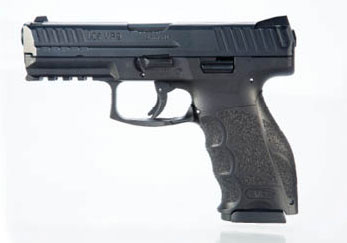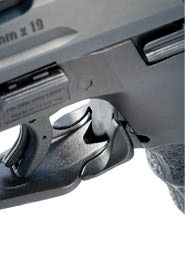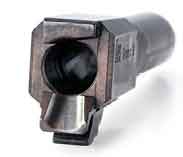
Webster tells us that "innovation" is a method, device or idea that is new. Further, it is accepted that those who come up with these methods, devices and ideas are innovators. I believe that when it comes to modern service firearm innovations, no one can outdo the German gunmaker Heckler & Koch. There's plenty of evidence to support that position. Unlike the old-time European gunmakers of the pre-World War II era, HK began its production as German industry began to rebuild after the war. In the last half of the 20th Century, it introduced a succession of radical new guns to the military, police and personal-defense markets.
While the first of those-a blowback pocket semi-automatic-was influenced by the pre-war Mauser HSC, guns that followed were pretty much all HK. The company not only found new ways to build guns, it found new guns to build. That was certainly the case with the VP70 semi-automatic 9 mm of 1970, a high-capacity, heavy-duty service pistol with one of the earliest double-action-only trigger systems. It was a pistol that transformed into a submachine gun of sorts when fitted with a proprietary holster/buttstock assembly. It was also a gun with a major portion of the receiver made from polymer. That latter trait was shared with the later P9S, a more conventional semi-automatic with a refined trigger action. And then there was the P7, HK's so-called "squeeze cocker" that combined innovation in the lockwork with equal innovation in the breech locking system. P7s were often erroneously called "gas-operated" on the assumption the gas system operated the gun, when it actually momentarily kept the cycle from progressing-a form of gas-delayed blowback. In more modern times, the HK designers came up with the USP series pistols to fulfill every conceivable demand of lockwork operation.
Now, with the VP9, a striker-fired 9 mm Luger semi-automatic with a polymer frame, HK has developed arguably the best of its brand. At first glance, the company's newest offering is similar to most other service semi-automatics, with a blocky steel upper and polymer receiver. Its dimensions and weight-7.34"x5.41"x1.32" and 26.56 ozs.-are right in the middle of the pack. The barrel length is 4.09" and the sight radius is 6.38". You can't sell a 9 mm service pistol without a double-column magazine these days, and HK fit the VP9 with a 15-rounder. It is further in line with all the modern trends in the sense that it has an accessory rail molded into its dust cover that permits the user to install a range of aftermarket accessories-the most logical being a high-intensity light. Another feature of the VP9 that puts it into mainstream competition is the night sights. HK uses a luminescent material for the three-dot sight system rather than Tritium inserts. The benefit is slightly larger dots, although they do have to be charged often with a powerful light to renew their intensity.
More makers are becoming aware that left-handed shooters have a hard time managing semi-automatic pistols designed for the right-handed majority. They know that tactical situations often develop in which a gun needs to be operated from the off side. In the 21st century, pistols need to be at least tactically bilateral. By that, I mean the gun needs to be operable from the right and left side for those functions associated with actual, under-stress combat shooting. Field stripping doesn't fall into that category, but loading, firing and reloading certainly do. The new HK is very well laid out, with paddle-type, down-to-release magazine catches at the base of the trigger guard on both sides. Magazines drop free with no difficulty. Either right- or left-handed shooters can work the catch with either thumb or trigger finger. It also has a slide lock on both sides of the receiver, positioned under the thumb. The slide lock is necessary for manually locking the slide to the rear in clearing certain types of malfunctions. The pistol ejects fired cartridges right and forward in a pattern that is acceptable for both right- and left-handed users.
Field stripping of the VP9 is much like that of other modern guns. Unload the gun and remove the magazine. Retract the slide and lock it to the rear. Pivot the takedown lever (on the left upper edge of the receiver) 90 degrees, then pull the slide forward off the frame. Turn the slide over and press the barrel and recoil spring forward, then slightly to the side to remove them from the assembly. The barrel will come out of the slide when the shooter presses up on the breech end. That is about as far as you need to go for normal maintenance.
In my view, the VP9 excels in two general areas-ergonomics and operational efficiency. The receiver is made of polymer, with sheet metal rails and related slide interface parts secured to it. In a very real sense, the use of polymer in gunmaking has been revolutionary. Heckler & Koch took advantage of this and crafted the most ergonomically sound pistol I have yet fired. The sweeping curves that make up the VP9 receiver are easily manufactured in a mold and do not require complex, expensive machining operations.
For example, starting with the frontstrap, its angle to the barrel/slide assembly is close to that of the M1911 and facilitates deliberate aimed fire if not quick point shooting. To increase contact with the shooter's hand in this critical area, HK built three shallow finger grooves in the VP9 frontstrap, with the bottom one just slightly deeper than the others. That's because this groove takes the little finger, which is a bit shorter. To the rear of the frontstrap on both sides, the grip surface swells out in the middle and is thinner at both top and bottom.
There's a matching curve on the backstrap and the effect of the shaping is to give the butt of the gun a somewhat lemon-like contour. Until you get to the magazine well at the bottom, there are no flats or straight lines in the VP9 butt. There is a deep curved pocket that takes the web of the shooter's hand and, just forward of that, there are smooth approaches to the trigger guard. One side takes the extended trigger finger and the other forms a thumb rest of sorts.
Most grip surfaces of the pistol feature panels of a grainy, crackle-like texture. It affords the shooter a nice mix of adhesion and comfort. I noticed it the moment I took the gun from its box. It seemed comfortable then, and I shot it just as I got it.
But we need to also look at Heckler & Koch's interesting system of stock panels and backstraps. In neat little recesses in the foam of the VP9 shipping box, the buyer gets right and left stock panels in two sizes, as well as two sizes of backstraps. Another pair is on the gun itself, as well as another backstrap. It is an easy matter to change them out to suit an individual shooter's needs and preferences. There are three right-side panels, three left ones and three different backstraps. I set it up to be as small as possible, and I tried it with the largest panels in place. It's really clever, and I am surprised at the degree of difference between the two. You can tailor the gun to your preference and that includes an asymmetric arrangement with a thicker panel on one side or the other. In essence, this is what renowned handgunner Elmer Keith used to do by using thicker or thinner slabs of stag horn on opposite sides of his revolvers.
There is yet another ergonomic feature that has to be seen as an innovation of sorts. Although it has occasionally appeared on other designs, it is so logical that I am surprised we haven't seen it more often. Heckler & Koch calls them "charging supports." At the rear end of the slide, there's a panel of cocking serrations on both sides. They are rather widely spaced and at a point near the back edge of the rear sight, there is a removable ridge of steel on each side of the slide. They extend up from the flat side of the slide perhaps approximately 1/8". When a shooter finds it necessary to rack the slide, they allow better purchase on the gun. They are removable (who would want to?) and can be replaced with level inserts. The charging supports are in exactly the right place and vastly ease the effort needed to rack the slide. In the dark and under stress, with hands wet with mud, water or even blood and perhaps even when wounded, a shooter can use all the help he can get.
Although the VP9 will probably be confused with or even identified as a double-action-only system, it is not. When the action of the gun cycles and the barrel unlocks, the slide recoils and compresses the recoil spring. At the rearmost point of slide travel, the striker in the slide is fully cocked. When the moving parts go back into battery, the striker stays cocked. Trigger pressure clears the articulated trigger safety and an inner drop safety, then releases a fully cocked striker to fire. In current jargon, that is a single-action pistol. Some 5 lbs. of trigger pressure fire the gun, and it is the same for every shot the gun delivers. The implications of such a system are enormous. The trigger stroke is shorter than any of the double-action-only designs and as light as the best of them. Reset is quite short and there is only a very slight creep to the trigger pull. Best of all, it is a simple operating drill, with no intermediate steps of manipulating safeties or other controls. Basically, you just aim the VP9 and pull the trigger.
In preparing this report, I fired several hundred rounds of varied 9 mm Luger ammunition. I even found a box of hot G.I. ball ammunition that I used for one leg of the accuracy evaluation. I was impressed with the gun's handling, particularly when I deliberately limp-wristed it or shot it upside-down or sideways. There were simply zero malfunctions. The pistol cycled with monotonous regularity, digesting a wide assortment of ammunition. Tabulated accuracy results were derived from shooting off sandbags on a bench. Several groups were right at 2" and a couple were under that mark.
I have had the fun of shooting pretty much all of the HK pistols, and this one is an easy favorite. There is little in the operational system of the VP9 that I can criticize, and the ergonomics and trigger action are clearly superior. I have no knowledge of forthcoming models in other calibers or sizes, but a line extension wouldn't surprise me. Most companies are in the process of developing an economy service pistol, and this must be HK's since it is priced in the $700 range. It is a good buy at that.
While HK's new VP9 is a departure from the company's most recent offerings, it upholds the high-quality standards of its stablemates and introduces new features that are sure to appeal to both longtime HK fans and to newcomers alike.











































